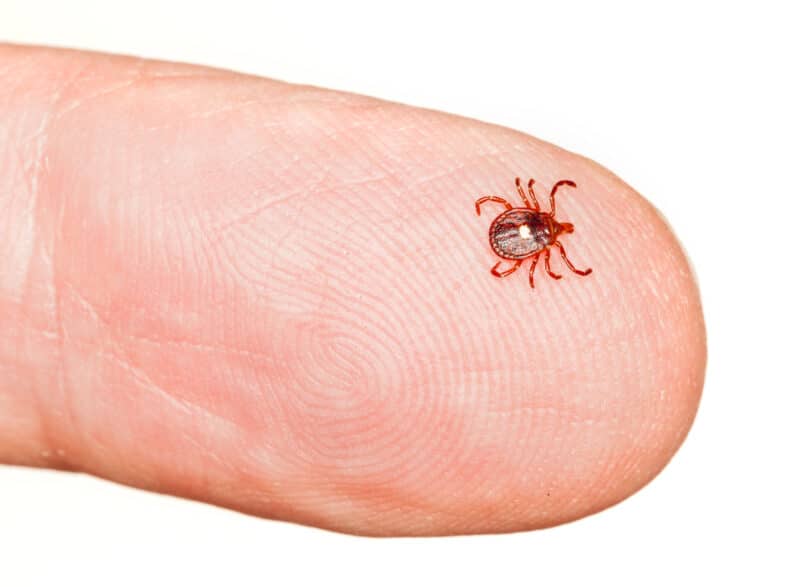by Dr. Sarah Treanor Bois, PhD
Director of Research & Education at the Linda Loring Nature Foundation
I first encountered Lone Star ticks on Tuckernuck Island in 2015. I had one adult female hitchhike back to Nantucket on me, and I reported it to Tick Report. At the time, it was only the second report from Nantucket, with many more known from Tuckernuck Island. Of course, birds fly easily from one island to another, and deer swim. It was just a matter of time before Nantucket and all of its available habitat became the next place for Lone Star ticks to populate.
Since then, lone star ticks (Amblyomma americanum) have become established and even dominant in parts of Nantucket. This started in the western end, and they are now found across the island, all the way to the eastern end.
So why are there lone star ticks now and why are they getting worse? The lone star tick is one example of a range-expanding species responding to climate change. Their distribution has been expanding from south-eastern, south-central, and mid-Atlantic states, with warming climate making larger swaths of the northern U.S. more hospitable to lone star ticks.
Or are they? Some experts believe that lone star ticks were prevalent in parts of the northeastern U.S. during the 1700s and that they now they are reclaiming that habitat. Centuries ago, primary forest habitat and deer populations were at their peak and so were the ticks, as we know from written descriptions and collections of the period. The 1800s brought expanded colonization, which resulted in significant forest cutting and hunting pressure on deer populations, leading to decreases in tick populations. Now, with forests recovering from decades of logging, white-tailed deer populations have rebounded, and winters are getting warmer due to climate change. It’s a perfect storm for the ticks to be taking over. This combination could mean continued expansion of lone star ticks, which are now established from Florida to Maine and as far west as Nebraska.
Regardless of why they’re here, they are here. So what do we need to look out for? Lone star ticks are notable (and named) for the distinctive white dot on their reddish-brown bodies, which is only found on adult females. The adult males have white dots or streaks on the outer edges of their bodies. Nymphs are smaller and distinguished by reddish-brown bodies and fast speed. Yes, they will “run” up your clothes upon contact.
Lone star ticks are known to be more aggressive than deer and dog ticks: they actively “hunt” down a host instead of passively hoping one walks by since they are attracted to carbon dioxide (basically, us breathing out). With a job working outdoors in the field and off-trail conducting research, I have a high exposure rate to ticks. Tromping around the grasses, shrubs, swamps, and other unmanaged habitats of Nantucket put me, and others in the same profession, at a higher risk of exposure. I thought I would share some of what we do to minimize tick bites.
The first and best line of defense is prevention. Keeping trails mowed and staying on paths is a good first step. We wear closed-toed shoes and long pants at all times. However, staying on mowed trails isn’t always possible when conducting research or looking for rare species. For work, I treat my field pants (the ones I wear out in the brush every day) with permethrin. I know that choice isn’t for everyone, but it is one I am personally comfortable with. I spray the outside of my field clothes with permethrin while I am not wearing them and let them dry in the sun. Supposedly, the permethrin will be effective for more than 40 washes. I generally reapply mid-summer.
Permethrin is a pesticide that is chemically similar to extracts of the flowering chrysanthemum plant. It acts on insects by over-stimulating their nervoussystems, leading to paralysis, and it’s an extremely effective insecticide against a wide variety of pests, including ticks. That means it’s also effective against other insects, including pollinators like butterflies and bees, so I don’t recommend spraying it broadly or spraying your yard.
It’s important to check periodically throughout the day for ticks and pull them off clothing right away. For tiny ticks—the nymphs—I recommend a heavyduty lint roller. Amazon sells some that are “extra sticky” to assist with pet hair. Duct tape also works.
The real question everyone asks is: what do I do once I’ve been bitten by a tick? I will preface this by saying you should, of course, consult a medical professional. I can tell you that my advice has changed with the presence of lone star ticks.
If you find blacklegged ticks (formerly known as deer ticks) biting you, you must to get their entire body off/out of you ASAP. If the tick was on you for less than 24 hours, generally you should be fine. You may have to treat the bite site for itch and irritation, but theres’s a low risk of other infections. However, if you think the tick has been attached longer than 48 hours, you should be tested for tick-borne illnesses and start antibiotic treatment if necessary. In that slim window between 24- and 48-hours, you can sometimes treat with a prophylactic dose of antibiotics to ensure the infection doesn’t spread. But, again, consult your doctor. The staff at the urgent care clinic at our hospital are experienced in treating tick bites.
Lone star ticks are different. Unlike other ticks, their long mandibles mean that their bites can feel like a little sting. Like other ticks, they go for moisture, so they bite in places like armpits, back of the knees, and other nether-regions. The difference in a lone star tick bite is that they can bite and keep going. They don’t always burrow in. That’s great because they don’t stay, but it also means one tick can bite multiple times. And they are itchy! It may be my personal reaction, but lone star tick bites itch a lot and for a long time (up to two weeks!). I treat them like I treat poison ivy rash or other bites: with cortisone cream or Benadryl.
The good news about lone star ticks is that, overall, they have a much lower infection rate for tick-borne diseases. According to our state website, “Lone star ticks are not a significant source of human illness in Massachusetts at this time but are capable of spreading tularemia, ehrlichiosis, and southern tick-associated rash illness (STARI),” however, the prevalence of these infections is much lower.
The other aspect of lone star ticks that sends a shiver of fear through my meat-loving husband is that these ticks can cause Alpha-gal syndrome. Alpha-gal syndrome (or AGS) is what is commonly called the “meat allergy.” Getting bitten by a lone star tick doesn’t always make you allergic to meat. Everyone reacts differently: it’s caused by a combination of genetics, how many bites you get, how long the tick remains. Alpha-gal stands for galactose-alpha-1,3-galactose, a sugar that’s found in red meat, including pork and beef, as well as certain animal products, such as milk and gelatin. It’s also found in the saliva of lone star ticks. When some people are bitten by the lone star tick, their immune system reacts to the alpha-gal, and the next time they eat red meat, their antibodies produced in response to the tick bite go overboard and cause a hyperactive immune response, similar to how a person allergic to bees responds to a bee sting.
This is a new and emerging issue and, as such, it’s a new area of research. AGS was only formally recognized in the medical community in 2009. According to a Center for Disease Control (CDC) report, between 2010 and 2022, more than 110,000 suspected cases of AGS were identified. However, cases of AGS are not nationally notifiable to CDC, so the actual number of AGS cases in the United States is likely underestimated. More data and research are needed. There is little known about how the tick bite causes AGS or why certain people develop it.
AGS has to be diagnosed by a health-care professional. As with many allergies, the actual severity of the allergy is individualized. People who suffer from AGS may experience a wide range of symptoms, including hives or itchy rash; nausea or vomiting; heartburn or indigestion; diarrhea; cough; shortness of breath or difficulty breathing; swelling of the lips, throat, tongue, or eye lids; dizziness or faintness; or severe stomach pain. Symptoms commonly appear 2- 6 hours after eating food or other exposure to products containing alpha-gal.
The people I know on Nantucket who have the alpha-gal syndrome have described experiencing severe gastric distress after eating meat, swollen lips and mouth, and/or rashes. None has gone into anaphylactic shock, but all have changed their diets to stop eating red meat. Some people can still have dairy, while others find they have a reaction to it. The important thing to remember if you think you have these symptoms is to check with your health care professional.
One piece of good news is that, for some people, the alpha-gal syndrome can lessen and even disappear over time.
It looks like we’ll be living with lone star ticks for the foreseeable future. Knowing the risks and taking steps towards prevention is the key. We can all still get outside and enjoy nature!
For more information about prevention, what to do about ticks in your yard, or actions to take if you’ve been bitten, the Cape Cod Cooperative Extension program has a wealth of information posted on the Barnstable County website: capecod.gov/departments/cooperative- extension/programs/ticks-bugs. Even though it’s based on the Cape, the information is very relevant for Nantucket.



